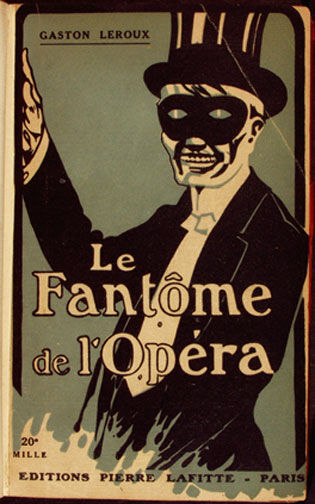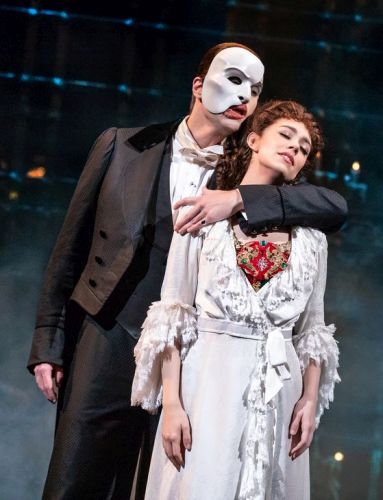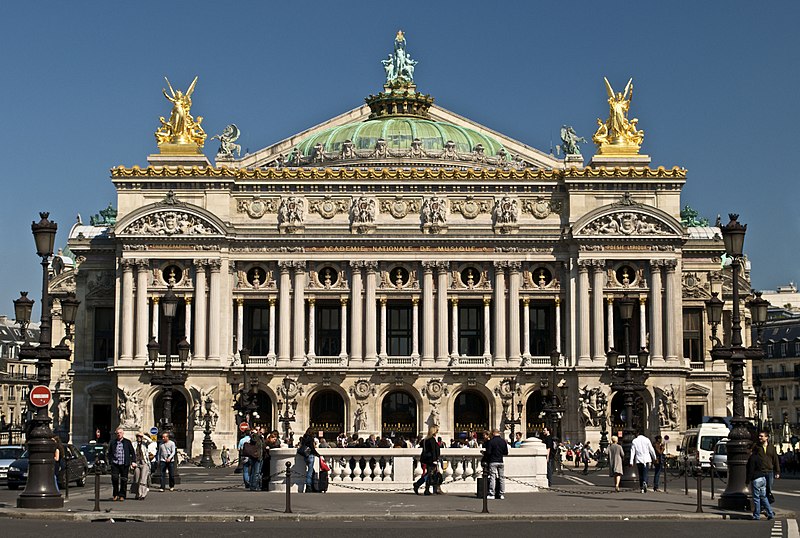The Phantom of the Opera by Gaston Leroux
by Rose
 The dramatic opening organ chords introduce composer Andrew Lloyd Webber’s theme for the masked phantom, one of the most extraordinary gothic characters to grace fiction, the creation of journalist Gaston Leroux. Transferred from book to stage, the phantom is a triumphant, stylishly decadent orchestrated sensation. The musical masquerade is a exotic masterpiece: a visually seductive choreographed scene, where dancers hide behind decorative masks and shimmering costumes. The phantom’s horrifying disfigurement has caused society to abandon him, forcing him to live underground. He is unable to alter his visual appearance, preventing his constant dream of love becoming a reality. What happens to a man who is stigmatised and rejected from childhood? Though the phantom commits vengeful acts throughout the story and is undoubtedly insane, Leroux masterfully elicits sympathy from the reader. The phantom, we are told, is a man that has never known love, not even from his mother as a little boy. Leroux adeptly manipulates the reader’s emotions throughout the novel, producing contradictory and multi-layered features of his creation’s personality: a madman, a genius composer, a rejected child, a killer, considerate music teacher and a man craving for love. The complexity of the phantom’s personality is like an intricately crafted puzzle box. At times, the narrative can be melodramatic, yet, somehow, Leroux is absolved for this transgression. The novel is a classic example of early 20th century gothic horror. The phantom’s story is set in the opulent and wondrous Paris Opera House, itself designed by an architect that understood the art of creating mystery. It is constructed like a labyrinth, with hidden passages, trap doors and endless secret rooms including the magical mirror, the entrance to the phantom’s dark world. Leroux brings the flourishing working theatrical world vividly to life, in a kaleidoscopic world of ravishing colour, intriguing characters and striking visionary narrative. The phantom’s world lies beneath the bustling illuimated Opera house, in a beguiling netherworld, a masterwork of invention by Leroux.
The dramatic opening organ chords introduce composer Andrew Lloyd Webber’s theme for the masked phantom, one of the most extraordinary gothic characters to grace fiction, the creation of journalist Gaston Leroux. Transferred from book to stage, the phantom is a triumphant, stylishly decadent orchestrated sensation. The musical masquerade is a exotic masterpiece: a visually seductive choreographed scene, where dancers hide behind decorative masks and shimmering costumes. The phantom’s horrifying disfigurement has caused society to abandon him, forcing him to live underground. He is unable to alter his visual appearance, preventing his constant dream of love becoming a reality. What happens to a man who is stigmatised and rejected from childhood? Though the phantom commits vengeful acts throughout the story and is undoubtedly insane, Leroux masterfully elicits sympathy from the reader. The phantom, we are told, is a man that has never known love, not even from his mother as a little boy. Leroux adeptly manipulates the reader’s emotions throughout the novel, producing contradictory and multi-layered features of his creation’s personality: a madman, a genius composer, a rejected child, a killer, considerate music teacher and a man craving for love. The complexity of the phantom’s personality is like an intricately crafted puzzle box. At times, the narrative can be melodramatic, yet, somehow, Leroux is absolved for this transgression. The novel is a classic example of early 20th century gothic horror. The phantom’s story is set in the opulent and wondrous Paris Opera House, itself designed by an architect that understood the art of creating mystery. It is constructed like a labyrinth, with hidden passages, trap doors and endless secret rooms including the magical mirror, the entrance to the phantom’s dark world. Leroux brings the flourishing working theatrical world vividly to life, in a kaleidoscopic world of ravishing colour, intriguing characters and striking visionary narrative. The phantom’s world lies beneath the bustling illuimated Opera house, in a beguiling netherworld, a masterwork of invention by Leroux.
 This is a place with a glistening lake, a room of polished mirrors creating an infinite number of reflections, altering the perception of the spectator and distorting visual reality. Despite his darkness, the phantom is a master of song, teaching his beautiful, yet tragic, protégé to sing angelic soprano soundscapes, where every octave elevates the heart and makes audiences feel they are being swept up into boundless heavens. The novel asks many questions: was the phantom born insane? Has he been driven crazy by the way human beings in society have treated him? What happens to the mind of a person starved of love and affection? Does love, like the phantom visualises it, even exist in reality? Leroux creates a compelling tale and his character still makes a powerful impact in the modern age. A character that can capture the imagination of thousands of theatregoers each week, one hundred and ten years after the story was published, deserves admiration.
This is a place with a glistening lake, a room of polished mirrors creating an infinite number of reflections, altering the perception of the spectator and distorting visual reality. Despite his darkness, the phantom is a master of song, teaching his beautiful, yet tragic, protégé to sing angelic soprano soundscapes, where every octave elevates the heart and makes audiences feel they are being swept up into boundless heavens. The novel asks many questions: was the phantom born insane? Has he been driven crazy by the way human beings in society have treated him? What happens to the mind of a person starved of love and affection? Does love, like the phantom visualises it, even exist in reality? Leroux creates a compelling tale and his character still makes a powerful impact in the modern age. A character that can capture the imagination of thousands of theatregoers each week, one hundred and ten years after the story was published, deserves admiration.
Themes
Romance
In the story, the childhood sweetheart Raoul who was born into the the upper classes of society, is totally in love with Christine. He views Christine as perfect, innocent, almost angelic. His construction of her, is driven by his perception, that she is frail and helpless, beautiful and innocent and requires saving. However, the upper classes can only marry into their own class and he struggles with his family loyalty with his love. Christine loves him, but despite the horrors, she describes, when discussing the Phantom, and his face and personality, it’s obvious she admires the genius of the Phantom, who is a brilliant composer, and she feels great sympathy for him, because he is disfigured and has never known love. He is also her teacher, and it’s obvious that she feels he helped her improve her soprano voice, without him she would never have excelled. As all students feel for their teachers, she has feelings for the gift her has given her. There is a great deal of romantic elements in the ‘Phantom of the Opera’ with Christine being loved by two men. The phantom weeps and begs Christine in moments, at others, he rages in torment, driven mad by his rejection by society and his inability to experience love from a female. The phantom has only been able to fantasise about love, never experience it, his view of love is completely idealistic. One question in the novel is ‘Does the phantom’s visual dream of romantic love, actually exist in reality? When someone has never experienced, what should have been a normal emotion, do they fantasise and create images of what they think love is like, but do his dreams exist in reality? The phantom’s dreams are the dreams of love are romantic and youthful, and though he tries to force love onto Christine, it’s true to say, that the phantom knows this would never work, however, he is stuck inside his fantasy of love and cannot escape it. Starved of any affection and love he cannot leave his fantasy of love.
Social Classes
The Opera House is described as luxurious and opulent, yet outside on the streets are beggars, prostitutes and thieves with people living destitute and in poverty. Many of the people visiting the Opera house are from the middle to upper classes of society. The differences and rules of the social classes feature prominently in the novel. Christine comes from poverty, and the upper social classes are unlikely to accept her as a bride to a distinguished upper-class family despite her operatic singing.
Power Relations
The phantom negotiates terms with the Opera House managers, if they refuse, he causes accidents and creates disorder until they agree to pay him a fee. The phantom continually wields his power and his knowledge of the Opera Houses’ architectural design to achieve what he wants. However, it could be said that he has very few choices in life, he has had to learn to survive in society somehow, despite his disfigurement, one could say that society has created this situation by its treatment of him. He has become adept at having to fight for every right due to his disfigurement. He is very controlling, and at times treats Christine as if she does not have the right to her own mind. That she is a mere doll in his hands, and he is moulding her into what he believes is the perfect female and wife. Then again, the young handsome Raoul, can also be controlling in the way that he expects Christine to give in to him throughout the novel. He also views her as something he wants to own, in the same way as the phantom throughout the novel. Both feel Christine belongs to them. Both are dominant male figures in their own way, though the phantom, has indeed, lost his mind. Raoul is behaving towards female as was expected at the time the novel is set.
Christine - depiction of the female lead
Christine is a very weak figure in the novel and portrayed as extremely vulnerable. She is talented and gifted but seems unable to have any power or control over her own life and relies on men to help her. Although gifted it’s true to say that Leroux makes it clear that without the phantom’s tutoring, she would never have reached the masterful stage she has as a soprano. This depiction of a female lead character is typical of romantic gothic novels of the time. Though, this was very true to the historical time in which the novel was written. In those days, women had little power compared to men. Christine is also vulnerable as she has lost both parents at an early age. Life is very difficult for Christine; her only way to survive and not end up on the streets living in poverty, is to sing at the Opera house, and be employed by them. Christine has few choices in life.
The Opera House as character

The Opera House does become a main character in the novel, its complex design creates a presence, almost a personality in the scenes in the novel. The way that sound carries from room to room, from stage to the back of the theatre and through corridors, and the fact that the Phantom knows every room, and can hear all conversations, enables the building to be in his power, more than any person that works there, including the managers. But the lavish building itself is a figure of strength, it attracts the upper classes to its seats, it’s a place of power in society, and it affects all characters in the novel.
Stigma and disfigurement
It’s not unusual for characters in fiction with disfigurements to be depicted as insane, or killers. In fiction and films, many disfigured characters are represented badly. However, despite the phantom being described as a figure of horror and of being cast as crazy in the novel, Leroux does present the phantom as a genius, as a man that creates composition masterpieces. He is also depicted as highly intelligent with a sense of humour. His characters are much more complex than many characters with disfigurements featuring in fiction. The phantom also has power, he has charisma despite his horrifying face. One of the themes is the stigma and the way that the phantom has been unloved by his mother, human beings and society. He is judged completely on his outside appearance as if this is the gateway to his personality. His disfigurement, his ugliness is judged to be his very identity. No one looks beyond this, except Christine, though horrified by his looks understands his talents and his tragedy. Still, visual looks in the novel are commended in society and ranked highly. Society is seen as a very harsh place for anyone who looks different and does not fit in.
Symbolism
Mirrors feature heavily in the novel, the entry to the Phantoms dark world is through a mirror of light. One moves from light to darkness in through the mirror. Inside his home, the Phantom has created a torture chamber of mirrors, that distorts the mind and terrifies Raul creating hallucinations. Mirrors are often symbols of dreams and entries to other worlds, they have magical qualities, in the novel the mirrored room creates the illusion that what is seen goes on forever, a trick of the illusionist, yet even a trick can alter a person’s perception of reality. Mirrors can also be features of the unconscious mind.